| September 23, 2008 |  |
MarsDaily Advertising Kit |
| Previous Issues | Sep 22 | Sep 19 | Sep 18 | Sep 17 | Sep 16 |
Growing Library Of Mars Spectrometer Images Pasadena CA (SPX) Sep 23, 2008
Pasadena CA (SPX) Sep 23, 2008A September 2008 release of 1,575 new images, such as this one, from the Compact Reconnaissance Imaging Spectrometer (CRISM) on NASA's Mars Reconnaissance Orbiter brings the number of released, high-resolution CRISM images to 4,580. This image in enhanced color from visible-light wavelengths shows light-toned rugged highland material in an area near the Martian equator. It covers an area ... more Morning Frost In Trench Dug By Phoenix  Pasadena CA (SPX) Sep 23, 2008
Pasadena CA (SPX) Sep 23, 2008This image from the Surface Stereo Imager on NASA's Phoenix Mars Lander shows morning frost inside the "Snow White" trench dug by the lander, in addition to subsurface ice exposed by use of a rasp on the floor of the trench. The camera took this image at about 9 a.m. local solar time during the 113th Martian day of the mission (Sept. 18, 2008). Bright material near and below the ... more NASA's Phoenix Lander Might Peek Under A Rock  Tucson AZ (SPX) Sep 23, 2008
Tucson AZ (SPX) Sep 23, 2008If the robotic arm on NASA's Phoenix Mars Lander can nudge a rock aside, scientists on the Phoenix team would like to see what's underneath. Engineers who develop commands for the robotic arm have prepared a plan to try displacing a rock on the north side of the lander. This rock, roughly the size and shape of a VHS videotape, is informally named "Headless." "We don't know whether we ... more Spirit On Light Duties For Now  Pasadena CA (SPX) Sep 23, 2008
Pasadena CA (SPX) Sep 23, 2008Spirit continues to conserve solar power while performing light science activities during the Martian winter. During the past week, Spirit studied the atmosphere and acquired two frames of the full-color image mosaic known as the "Bonestell panorama." Spirit is healthy and all subsystems are performing as expected as of the relay of information from NASA's Odyssey orbiter on sol 1666 ... more NASA's Mars Rover To Head Toward Bigger Crater  Pasadena CA (SPX) Sep 23, 2008
Pasadena CA (SPX) Sep 23, 2008NASA's Mars Rover Opportunity is setting its sights on a crater more than 20 times larger than its home for the past two years. To reach the crater the rover team calls Endeavour, Opportunity would need to drive approximately 12 kilometers (7 miles) to the southeast, matching the total distance it has traveled since landing on Mars in early 2004. The rover climbed out of Victoria Crater ... more |
mars-water-science
 mars-mers 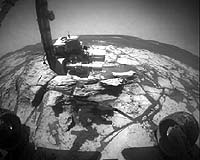 mars-general 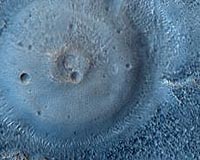 |
 Tucson AZ (SPX) Sep 18, 2008
Tucson AZ (SPX) Sep 18, 2008Water may have played a role in shaping parts of the Martian landscape a billion years longer than previous studies have shown, according to a research team led by Catherine Weitz, a senior scientist with the Planetary Science Institute. Their research, to be published in "Geophysical Research Letters" and now available online, presents strong evidence that sustained and large-scale process ... more More Soil Delivered To Phoenix Lab  Pasadena CA (SPX) Sep 17, 2008
Pasadena CA (SPX) Sep 17, 2008This image, taken by NASA's Phoenix Mars Lander's Surface Stereo Imager, documents the delivery of a soil sample from the "Snow White" trench to the Wet Chemistry Laboratory. A small pile of soil is visible on the lower edge of the second cell from the top. This deck-mounted lab is part of Phoenix's Microscopy, Electrochemistry and Conductivity Analyzer (MECA). The delivery was made ... more NASA Selects CU-Boulder To Lead Mars Mission  Boulder CO (SPX) Sep 17, 2008
Boulder CO (SPX) Sep 17, 2008In the largest research contract ever awarded to the University of Colorado at Boulder, the Laboratory for Atmospheric and Space Physics has been selected by NASA to lead a $485 million orbiting space mission slated to launch in 2013 to probe the past climate of Mars, including its potential for harboring life over the ages. The team, led by CU-Boulder's LASP, will design, build and ... more NASA Selects MAVEN Mission To Study Mars Atmosphere  Washington DC (SPX) Sep 16, 2008
Washington DC (SPX) Sep 16, 2008NASA has selected a Mars robotic mission that will provide information about the Red Planet's atmosphere, climate history and potential habitability in greater detail than ever before. Called the Mars Atmosphere and Volatile EvolutioN (MAVEN) spacecraft, the $485 million mission is scheduled for launch in late 2013. The selection was evaluated to have the best science value and lowest ... more |
mars-mers
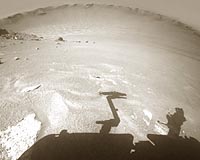 mars-phoenix 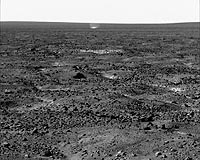 mars-life  |
 Tucson AZ (SPX) Sep 11, 2008
Tucson AZ (SPX) Sep 11, 2008The next soil sample that NASA's Phoenix Mars Lander will deliver to its deck instruments will go to the fourth of the four cells of Phoenix's wet chemistry laboratory, according to the Phoenix team's current plans. The chosen source for that sample is from the "Snow White" trench on the eastern end of the work area reachable with Phoenix's robotic arm. In July that trench yielded a ... more Underneath Phoenix Lander 97 Sols After Touchdown  Pasadena CA (SPX) Sep 10, 2008
Pasadena CA (SPX) Sep 10, 2008The Robotic Arm Camera on NASA's Phoenix Mars Lander took this image on Sept. 1, 2008, at about 4 a.m. local solar time during the 97th Martian day, or sol, since landing. The view underneath the lander shows growth of the clumps adhering to leg strut (upper left) compared with what was present when a similar image was taken about three months earlier. The view in this Sol 97 image is south ... more Mars Valleys Formed During Long Period Of Episodic Flooding  Santa Cruz CA (SPX) Sep 09, 2008
Santa Cruz CA (SPX) Sep 09, 2008A new study suggests that ancient features on the surface of Mars called valley networks were carved by recurrent floods during a long period when the martian climate may have been much like that of some arid or semi-arid regions on Earth. An alternative theory that the valleys were carved by catastrophic flooding over a relatively short time is not supported by the new results. ... more Rosetta Swings By Asteroid Steins 2867 On Route To Comet Churyumov  Paris (AFP) Sept 5, 2008
Paris (AFP) Sept 5, 2008A European spacecraft racing through the asteroid belt skimmed past a 10-kilometre (six-mile) space rock on Friday to carry out its first scientific work in a decade-long trek into the Solar System, mission controllers said. In a minutely choreographed operation, the one-billion-euro (1.45-billion-dollar) unmanned probe Rosetta - launched in 2004 by the European Space Agency ... more
|
mars-mers
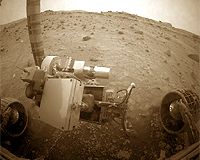 mars-phoenix 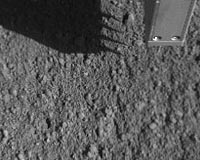 mars-mers 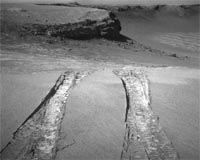 |
| Previous Issues | Sep 22 | Sep 19 | Sep 18 | Sep 17 | Sep 16 |
| The contents herein, unless otherwise known to be public domain, are Copyright 1995-2007 - SpaceDaily. AFP and UPI Wire Stories are copyright Agence France-Presse and United Press International. ESA Portal Reports are copyright European Space Agency. All NASA sourced material is public domain. Additional copyrights may apply in whole or part to other bona fide parties. Advertising does not imply endorsement, agreement or approval of any opinions, statements or information provided by SpaceDaily on any web page published or hosted by SpaceDaily. Privacy statement |